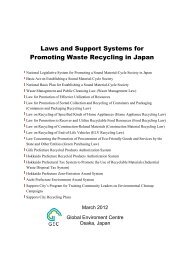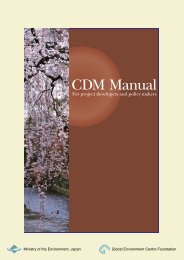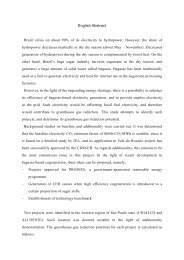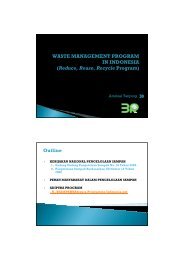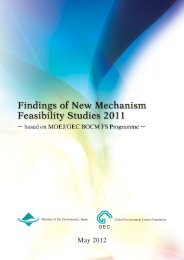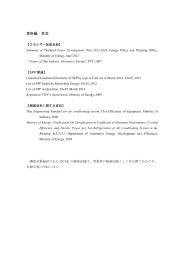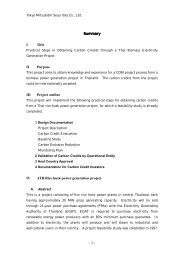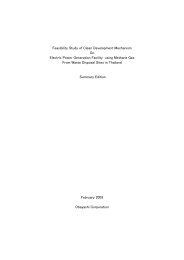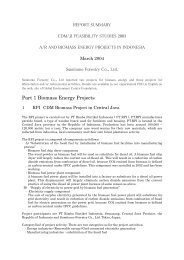PDF File - GEC
PDF File - GEC
PDF File - GEC
You also want an ePaper? Increase the reach of your titles
YUMPU automatically turns print PDFs into web optimized ePapers that Google loves.
identified on the basis of conservative assumptions, that the project scenario is not<br />
part of the identified baseline scenario and that the project will lead to GHG emission<br />
reductions or enhancements of removals;<br />
- Provision of traceable and transparent information that an accredited independent<br />
entity has already positively determined that a comparable project (to be) implemented<br />
under comparable circumstances (same GHG mitigation measure, same country, similar<br />
technology, similar scale) would result in a GHG emission reduction or an enhancement<br />
of removals that is additional to any that would otherwise occur and a justification why<br />
this determination is relevant for the project at hand.<br />
(c) The approach chosen, including its appropriateness, shall be justified as a basis for the<br />
determination referred to in paragraph 33 of the JI guidelines.<br />
[Annex 1 to the Guidance of criteria for baseline setting and monitoring version 01 (JISC04, Annex 6)]<br />
(4) Calculation of emission reductions or enhancements of removals<br />
(a) The GHG emission reductions or enhancements of removals generated by the project have<br />
to be estimated ex ante in the PDD of the project and calculated ex post according to the<br />
monitoring plan included in the PDD:<br />
• On a periodic basis;<br />
• At least from the beginning until the end of the crediting period;<br />
• On a source-by-source/ sink-by-sink basis;<br />
• In tonnes of CO 2 equivalent, using global warming potentials (GWPs) defined by decision 2/<br />
CP.3 or as subsequently revised in accordance with Article 5 of the Kyoto Protocol.<br />
(b) Reductions of emissions or enhancements of removals of GHGs generated by JI projects are<br />
estimated/ calculated by comparing the quantified GHG emissions or removals within the<br />
project boundary in the baseline scenario with those in the project scenario and adjusting for<br />
leakage. In practice, this estimation/calculation can be conducted, as appropriate, in one of<br />
the following two ways:<br />
• Assessment of GHG emissions or removals in the baseline scenario and in the project<br />
scenario:<br />
(i) Estimation/ calculation of GHG emissions or removals within the project boundary in<br />
the baseline scenario;<br />
(ii) Estimation/ calculation of GHG emissions or removals within the project boundary in<br />
the project scenario;<br />
(iii) Difference of the results of the estimations/ calculations referred to in subparagraphs (i)<br />
and (ii) above;<br />
(iv) Adjustment of the result of subparagraph (iii) above for leakage;<br />
• Direct assessment of emission reductions:<br />
(i) Direct estimation/ calculation of the difference between the GHG emissions within the<br />
project boundary in the baseline scenario and in the project scenario (e.g. in the case<br />
of landfill gas projects, the emission reductions can be calculated by multiplying the<br />
methane captured with an appropriate factor based on the GWP of methane);<br />
(ii) Adjustment of the result of subparagraph (i) above for leakage.<br />
(c) The project boundary chosen affects the identification of sources/ sinks for which emissions<br />
or removals have to be assessed when estimating/ calculating GHG emission reductions or<br />
enhancements of removals.<br />
[Annex 2 to the Guidance of criteria for baseline setting and monitoring version 01 (JISC04, Annex 6)]<br />
77




